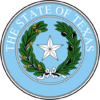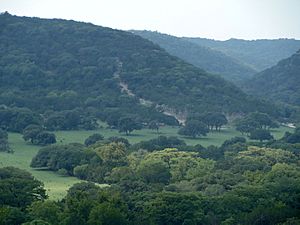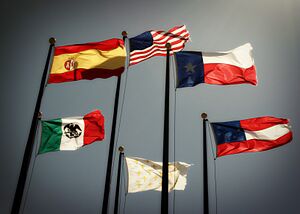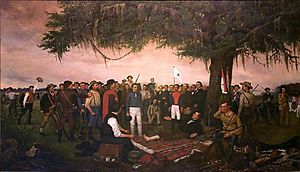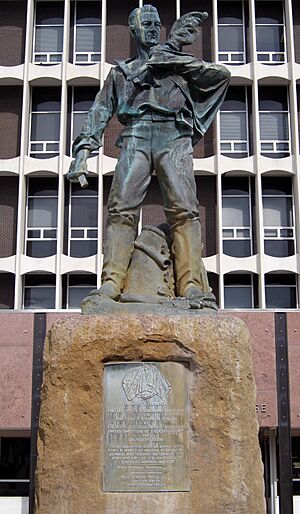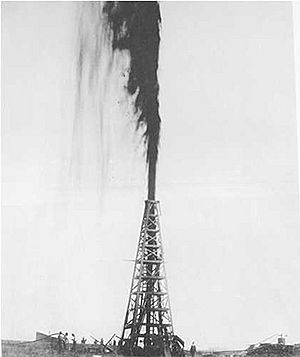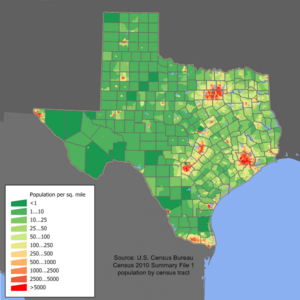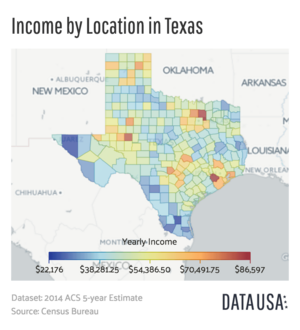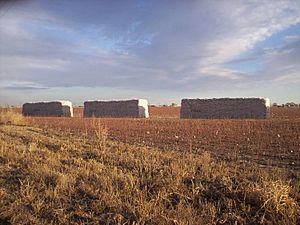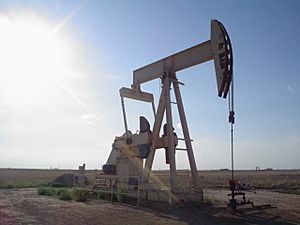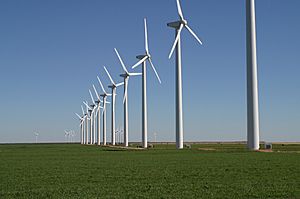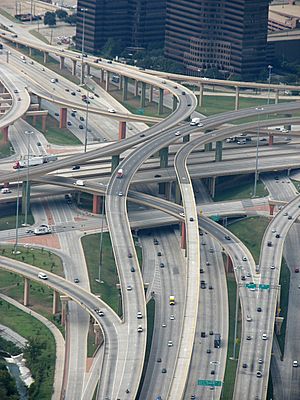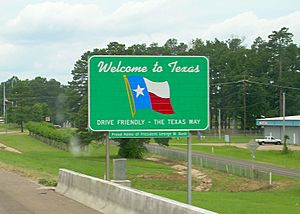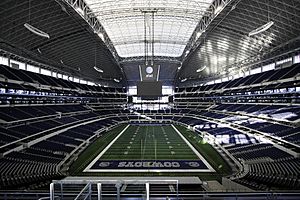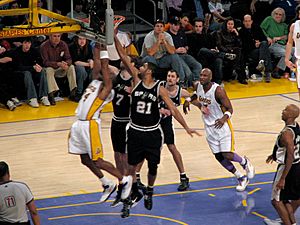Texas facts for kids
Quick facts for kids
Texas
|
|||
|---|---|---|---|
|
|||
| Nickname(s):
The Lone Star State
|
|||
| Motto(s):
Friendship
|
|||
| Anthem: "Texas, Our Texas" | |||
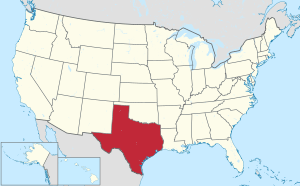
Location of Texas within the United States
|
|||
| Country | United States | ||
| Before statehood | Republic of Texas | ||
| Admitted to the Union | December 29, 1845 (28th) | ||
| Capital | Austin | ||
| Largest city | Houston | ||
| Largest county or equivalent | Harris | ||
| Largest metro and urban areas | Dallas–Fort Worth | ||
| Legislature | Texas Legislature | ||
| • Upper house | Senate | ||
| • Lower house | House of Representatives | ||
| Judiciary | Supreme Court of Texas (Civil) Texas Court of Criminal Appeals (Criminal) |
||
| U.S. senators | John Cornyn (R) Ted Cruz (R) |
||
| U.S. House delegation | 25 Republicans 13 Democrats (list) |
||
| Area | |||
| • Total | 268,596 sq mi (695,662 km2) | ||
| • Land | 261,232 sq mi (676,587 km2) | ||
| • Water | 7,365 sq mi (19,075 km2) 2.7% | ||
| Area rank | 2nd | ||
| Dimensions | |||
| • Length | 801 mi (1,289 km) | ||
| • Width | 773 mi (1,244 km) | ||
| Elevation | 1,700 ft (520 m) | ||
| Highest elevation | 8,751 ft (2,667.4 m) | ||
| Lowest elevation | 0 ft (0 m) | ||
| Population
(2024)
|
|||
| • Total | |||
| • Rank | 2nd | ||
| • Density | 114/sq mi (42.9/km2) | ||
| • Density rank | 23rd | ||
| • Median household income | $75,800 (2023) | ||
| • Income rank | 23rd | ||
| Demonym(s) | Texan Texian (archaic) Tejano (usually only used for Hispanics) |
||
| Language | |||
| • Official language | None | ||
| • Spoken language |
|
||
| Time zones | |||
| Majority of state | UTC−06:00 (Central) | ||
| • Summer (DST) | UTC−05:00 (CDT) | ||
| El Paso, Hudspeth, and northwestern Culberson counties | UTC−07:00 (Mountain) | ||
| • Summer (DST) | UTC−06:00 (MDT) | ||
| USPS abbreviation |
TX
|
||
| ISO 3166 code | US-TX | ||
| Traditional abbreviation | Tex. | ||
| Latitude | 25°50′ N to 36°30′ N | ||
| Longitude | 93°31′ W to 106°39′ W | ||
| Bird | Northern mockingbird (Mimus polyglottos) |
|---|---|
| Fish | Guadalupe bass (Micropterus treculii) |
| Flower | Bluebonnet (Lupinus spp., namely Texas bluebonnet, L. texensis) |
| Tree | Pecan (Carya illinoinensis) |
| Insect | Monarch butterfly (Danaus plexippus) |
| Game | Texas 42 dominoes |
Texas is a large state in the south-central part of the United States. It shares borders with Louisiana, Arkansas, Oklahoma, and New Mexico. To the south, it has an international border with Mexico. Texas also has a long coastline along the Gulf of Mexico.
Texas is the second-largest state in the U.S. by both land area and population. About 31 million people live there as of 2024. Its nickname is the Lone Star State because it used to be an independent country.
Spain was the first European country to claim Texas. Later, Mexico controlled the land until 1836. That year, Texas won its independence and became the Republic of Texas. In 1845, Texas joined the United States as the 28th state. This led to the Mexican–American War in 1846.
For a long time, Texas's economy was shaped by five main industries: cattle, bison, cotton, timber, and oil. The discovery of large oil deposits in the 20th century caused a huge economic boom. Today, Texas has a very diverse economy. It leads in many areas like tourism, agriculture, petrochemicals, energy, computers, aerospace, and biomedical sciences.
The biggest cities in Texas are Houston, San Antonio, and Dallas. The state capital is Austin. Texas has many different landscapes, from coastal swamps and forests to rolling plains, hills, and even deserts and mountains.
Contents
What Does the Name Texas Mean?
The name Texas comes from the Caddo word tejas. This word means "friends" or "allies." The Spanish used this name for the Caddo people and the area where they lived in East Texas.
For a while, during Spanish rule, the area was officially called Nuevo Reino de Filipinas: La Provincia de Texas.
Exploring Texas Geography
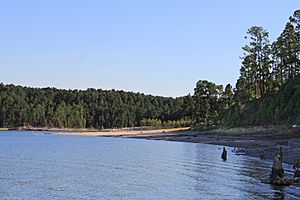
Texas is the second-largest U.S. state, right after Alaska. It covers about 268,820 square miles (696,200 square kilometers). To give you an idea, Texas is 10 percent larger than France!
Texas is located in the south-central part of the United States. Many of its borders are natural rivers. The Rio Grande forms a border with Mexico to the south. The Red River borders Oklahoma and Arkansas to the north. The Sabine River forms the border with Louisiana to the east.
Texas has 10 different climate zones and 11 unique natural regions. This means the state has a wide variety of soils, land shapes, rainfall, and types of plants and animals.
Texas Landscapes
The state can be divided into four main regions:
- The Gulf Coastal Plain is along the Gulf of Mexico in the southeast. It has thick pine forests.
- The Interior Lowlands have gently rolling hills and more pine-hardwood forests.
- The Great Plains region is in central Texas. It stretches through the Texas Panhandle and Llano Estacado to the Texas Hill Country near Austin. This area is mostly prairies and grasslands.
- "Far West Texas," also called the "Trans-Pecos" region, is a desert and mountain area. It has sand hills, desert valleys, and wooded mountain slopes.
Texas has 3,700 named streams and 15 major rivers. The Rio Grande is the largest. Other important rivers include the Pecos, the Brazos, and the Colorado. While Texas has few natural lakes, people have built over 100 artificial reservoirs.
Texas Geology and Rocks
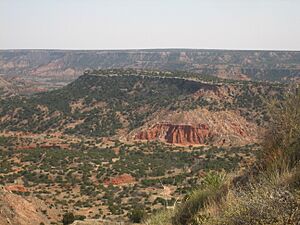
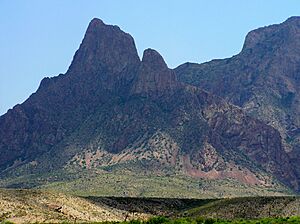
Texas is the southernmost part of the Great Plains. The oldest rocks in Texas are about 1.6 billion years old! These ancient rocks are mostly hidden underground but can be seen in places like the Franklin Mountains near El Paso.
Most of Texas is covered by younger rocks that formed from sediments. These sediments were laid down over millions of years as ancient oceans covered and then left the land.
The Gulf of Mexico began to form when the supercontinent Pangea started to break apart. This created a new coastline for Texas. Today, there are many miles of sediments buried under the Texas coast. These layers of rock hold a lot of the U.S.'s oil reserves.
Texas has very few volcanoes or earthquakes because it is far from where Earth's tectonic plates meet.
Amazing Texas Wildlife
Texas is home to a huge variety of animals and insects. You can find 65 types of mammals, 213 types of reptiles and amphibians, and 590 native bird species. That's the most bird diversity in the United States!
During spring, Texas highways are lined with beautiful wildflowers, including the state flower, the bluebonnet.
Texas Weather and Storms
Texas is a very large state, and its weather can change a lot from one area to another.
The Texas Panhandle in the north has colder winters than North Texas. The Gulf Coast has mild winters. Rainfall also varies greatly. El Paso in West Texas gets only about 8.7 inches (220 mm) of rain each year. Parts of southeast Texas can get as much as 64 inches (1,600 mm) per year!
Snow falls several times each winter in the Panhandle and West Texas mountains. In North Texas, it might snow once or twice a year. Central and East Texas see snow only every few years. South of San Antonio or on the coast, snow is very rare.
Summer temperatures are usually hot. Most areas of Texas have consistent summer highs around 90°F (32°C). In the Rio Grande Valley, it can reach 100°F (38°C).
Texas Storms and Hurricanes
Thunderstorms are common in Texas, especially in the eastern and northern parts. The northern section of Texas is part of Tornado Alley. Texas has the most tornadoes in the United States, with about 139 each year. They happen most often in North Texas and the Panhandle, usually in April, May, and June.
Some of the most powerful hurricanes in U.S. history have hit Texas. The 1900 Galveston hurricane was especially devastating. It killed about 8,000 people, making it the deadliest natural disaster in U.S. history. Other major hurricanes include Carla (1961), Beulah (1967), and Ike (2008).
A Look at Texas History
Early Texas: Before Europeans Arrived
Texas sits between two major Native American cultural areas: the Southwestern and the Plains regions. Archaeologists have found that three main groups lived here before Europeans arrived:
- The Ancestral Puebloans from the Rio Grande region.
- The Mississippian culture (Mound Builders) from the Mississippi River Valley.
- Civilizations from Mesoamerica (south of Texas).
Many different Native American tribes lived in what is now Texas. These included the Caddo, Comanche, Apache, Karankawa, and Tonkawa. The name Texas comes from a Caddo word meaning "friends" or "allies."
Whether a tribe was friendly or warlike greatly affected European explorers and settlers. Friendly tribes taught newcomers how to grow crops and hunt. Warlike tribes made life dangerous through their attacks.
European Colonization of Texas
The first map of the Texas coast was made in 1519 by Spanish explorer Alonso Álvarez de Pineda. Later, in 1528, Álvar Núñez Cabeza de Vaca became the first European to step foot in Texas.
In 1685, a French explorer named René-Robert Cavelier, Sieur de La Salle accidentally started a colony called Fort Saint Louis at Matagorda Bay. It only lasted four years because of harsh conditions and attacks from Native Americans.
Spain, worried about France, built several missions in East Texas in 1690. These were places to teach Native Americans about Christianity and Spanish culture. When France started settling Louisiana, Spain built more missions in East Texas in 1716. Two years later, they founded San Antonio as the first Spanish town in the area.
It was hard to get settlers to move to Texas because of hostile tribes and its distance from other Spanish colonies. Texas was one of New Spain's least populated areas. By the end of the 1700s, most tribes had peacefully converted to Christianity.
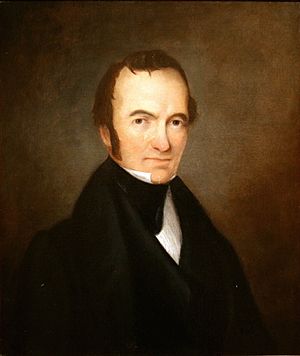
In 1803, the United States bought Louisiana from France. American leaders thought this deal also included Texas. The border between Spain and the U.S. was finally set at the Sabine River in 1819.
In 1821, Texas became part of Mexico after Mexico won its independence from Spain. Mexico wanted more people to move to Texas to help with Comanche raids. So, they allowed immigrants from other countries, including the United States.
The population of Texas grew very quickly. By 1834, most people in Texas were from the United States, not Mexico. Many of these new immigrants did not follow Mexican laws, especially the ban on slavery. Because of this, Mexico stopped allowing U.S. immigration in 1830. This angered both Mexican citizens living in Texas (called Tejanos) and the new immigrants.
The Republic of Texas
Tensions grew between Texans and the Mexican government. In late 1835, this led to armed conflict, starting the Texas Revolution. Texans fought and defeated all Mexican troops in the region.
On March 2, 1836, Texan leaders signed the Texas Declaration of Independence, creating the Republic of Texas. Meanwhile, Mexican President Antonio López de Santa Anna led an army to stop the revolt. His forces won early battles, including the famous Battle of the Alamo.
However, the Texian Army, led by Sam Houston, surprised and defeated Santa Anna's forces at the Battle of San Jacinto. Santa Anna was captured and forced to sign a treaty, ending the war.
Texas Becomes a U.S. State
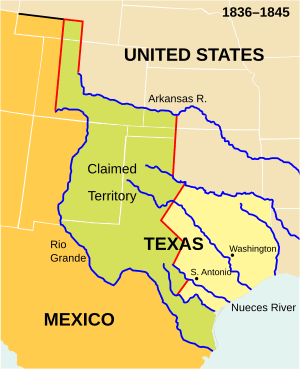
On December 29, 1845, Texas officially joined the United States as a state.
After Texas joined the U.S., Mexico broke off diplomatic relations. The U.S. claimed Texas's border stretched to the Rio Grande, but Mexico said it was the Nueces River. This disagreement led to the Mexican–American War in 1846. The first battles were fought in Texas. After the U.S. won, Mexico gave up its claim to Texas and other lands in the American Southwest.
In 1850, Texas's borders were set to their current shape. Texas gave up claims to land that became parts of New Mexico, Colorado, Kansas, Oklahoma, and Wyoming. In return, the U.S. government took on Texas's old debts.
The Civil War and Beyond
In 1861, Texas joined the Confederate States of America during the American Civil War. Many Texans fought for the Confederacy. The last battle of the Civil War was fought in Texas, near Brownsville.
After the Civil War ended in 1865, Texas rejoined the United States. The state then went through a long period of economic challenges.
The 20th Century and Modern Texas
In 1900, the deadliest natural disaster in U.S. history, the 1900 Galveston hurricane, hit Texas.
On January 10, 1901, a huge oil well called Spindletop was discovered near Beaumont. This started the "Texas oil boom" and completely changed Texas's economy. Oil production grew massively, making Texas a leader in the energy industry.
The Great Depression and the Dust Bowl in the 1930s hurt Texas's economy. Many people left the state during this time.
World War II had a big impact on Texas. The federal government invested a lot of money to build military bases and factories. Many young men joined the military, and cities grew with new industries.
On November 22, 1963, President John F. Kennedy was assassinated in Dallas.
How Texas is Governed
The current Texas Constitution was adopted in 1876. It separates the government's powers into three branches: executive, legislative, and judicial. Texas also has its own Bill of Rights, which is even larger than the U.S. Bill of Rights.
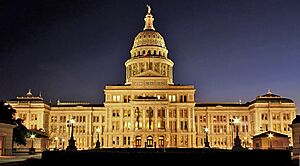
Texas has a governor, but their power is limited compared to governors in some other states. Voters elect many executive officers independently, meaning they answer directly to the public, not the governor. These positions include the lieutenant governor, attorney general, and others.
The Texas Legislature has two parts: the House of Representatives (150 members) and the Senate (31 members). The Legislature meets every two years for just over 100 days. However, the governor can call special meetings if needed.
Texas has a complex court system. There are two highest courts: the Supreme Court of Texas for civil cases and the Texas Court of Criminal Appeals for criminal cases. Judges are chosen by voters in elections.
People and Cultures of Texas
| Historical population | |||
|---|---|---|---|
| Census | Pop. | %± | |
| 1850 | 212,592 | — | |
| 1860 | 604,215 | 184.2% | |
| 1870 | 818,579 | 35.5% | |
| 1880 | 1,591,749 | 94.5% | |
| 1890 | 2,235,527 | 40.4% | |
| 1900 | 3,048,710 | 36.4% | |
| 1910 | 3,896,542 | 27.8% | |
| 1920 | 4,663,228 | 19.7% | |
| 1930 | 5,824,715 | 24.9% | |
| 1940 | 6,414,824 | 10.1% | |
| 1950 | 7,711,194 | 20.2% | |
| 1960 | 9,579,677 | 24.2% | |
| 1970 | 11,196,730 | 16.9% | |
| 1980 | 14,229,191 | 27.1% | |
| 1990 | 16,986,510 | 19.4% | |
| 2000 | 20,851,820 | 22.8% | |
| 2010 | 25,145,561 | 20.6% | |
| 2020 | 29,145,505 | 15.9% | |
| 2024 (est.) | 31,290,831 | 24.4% | |
| 1910–2020 | |||
As of 2024, Texas has an estimated population of over 31 million people. It is the second most populated state in the U.S., after California.
Texas has many foreign-born residents, making up about 17% of the population. Most immigrants come from Mexico, India, El Salvador, Vietnam, and China.
Texas's population density is about 96 people per square mile (37 people per square kilometer). This is a bit higher than the U.S. average. Most Texans live in big cities like Houston, Dallas, and San Antonio.
Diverse Backgrounds in Texas
Texas is a melting pot of different cultures. As of the 2020 census, the population includes:
- 40.2% Hispanic or Latino (of any race)
- 39.8% Non-Hispanic White
- 11.8% African American
- 5.4% Asian
- Other groups make up the rest.
Texas has the second-largest number of people of Mexican descent in the U.S.
Languages Spoken in Texas
| Language | Population (as of 2010) |
|---|---|
| Spanish | 29.21% |
| Vietnamese | 0.75% |
| Chinese | 0.56% |
| German | 0.33% |
| Tagalog | 0.29% |
| French | 0.25% |
| Korean and Urdu (tied) | 0.24% |
| Hindi | 0.23% |
| Arabic | 0.21% |
| Niger-Congo languages | 0.15% |
Most Texans (about 64%) speak only English at home. However, a large number (about 30%) speak Spanish. Other languages spoken in Texas include Vietnamese, Chinese, German, and French.
The main English accent in Texas is called Texan English, which is part of Southern American English. In South Texas, you might hear Chicano English, and in cities, African-American English is common.
Religions in Texas
| Religious affiliation (2020) | ||||
|---|---|---|---|---|
| Christian | 75.5% | |||
| Catholic | 28% | |||
| Protestant | 47% | |||
| Other Christian | 0.5% | |||
| Unaffiliated | 20% | |||
| Jewish | 1% | |||
| Muslim | 1% | |||
| Buddhist | 1% | |||
| Other faiths | 5% | |||
Most people in Texas are Christian, influenced by Spanish Catholic and American Protestant traditions. Texas is part of the "Bible Belt," a region in the Southern U.S. where Christianity is very important.
The largest Christian group is the Catholic Church. Among Protestants, there are many different groups like Baptists and Methodists.
Other religions are also present in Texas, especially in cities. These include Judaism, Islam, and Buddhism. Many people in Texas also say they are not affiliated with any religion.
Texas Economy and Industries
Texas has a huge economy, the second largest of any U.S. state, after California. If Texas were its own country, its economy would be one of the largest in the world!
Texas's economy is strong because of its large population, many natural resources, growing cities, and great universities. For a long time, the state's economy depended a lot on the oil industry. But now, Texas has a very diverse economy.
Texas is known for having a "low taxes, low services" approach. It is one of seven states that does not have a state income tax. Instead, the state collects money from property taxes and sales taxes.
Farming and Mining in Texas
Texas has the most farms and the largest amount of farmland in the United States. It leads the nation in how much money it makes from livestock (like cattle) and livestock products.
Beef cattle production is the biggest part of Texas agriculture. Cotton is the number one crop grown in the state by value. Texas also grows a lot of cereal crops and produce. The state also has a large commercial fishing industry.
In terms of mining, Texas leads in producing cement, crushed stone, lime, salt, sand, and gravel.
Energy Production in Texas
Energy has been a huge part of Texas's economy and politics since oil was discovered at Spindletop. If Texas were a country, it would be the sixth-largest oil producer in the world!
Texas has about one-fourth of all known U.S. oil reserves. Its refineries can process a huge amount of oil every day. The Port Arthur Refinery is the largest in the U.S. Texas also leads the nation in natural gas production. Many big oil and gas companies are based in Texas.
Texas is also a leader in renewable energy commercialization. It produces the most wind power in the nation. In 2014, over 10% of Texas's electricity came from wind turbines. The state also has a lot of potential for solar power.
Technology and Innovation
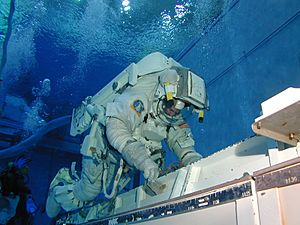
Texas has many large universities and programs that help new technology industries grow. The Austin area is even called "Silicon Hills" because of all the high-tech companies there. Many well-known tech companies like Dell and Texas Instruments have their headquarters or offices in Texas.
The Johnson Space Center in Houston is a major part of Texas's aerospace industry. Both SpaceX and Blue Origin have test facilities in Texas. Lockheed Martin builds fighter jets in Fort Worth.
Commerce and Trade
Texas's strong economy supports a big commercial sector. This includes retail stores, wholesale businesses, banking, insurance, and construction. Many large companies, not just those in traditional Texas industries, are based here.
The Dallas–Fort Worth area has more shopping malls per person than any other major U.S. city area.
Mexico is Texas's biggest trading partner. A third of Texas's exports go to Mexico, partly because of the North American Free Trade Agreement (NAFTA).
Getting Around Texas
Because Texas is so big, getting around can be a challenge. To help, Texas has built the largest highway and railway systems in America. The Texas Department of Transportation (TxDOT) manages these systems.
Texas is an important transportation hub. Trucks from the Dallas/Fort Worth area can reach most of the U.S. population within 48 hours.
Texas Highways
The first freeway in Texas was the Gulf Freeway, opened in Houston in 1948. As of 2005, Texas had over 79,535 miles (128,000 km) of public highways. To pay for new roads, Texas has many toll roads. One section of State Highway 130 has a speed limit of 85 mph (137 km/h), which is the highest in the nation. All federal and state highways in Texas are paved.
Airports in Texas
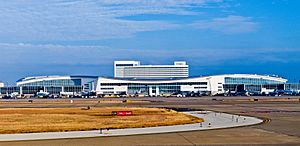
Texas has 730 airports, the second most of any state. Dallas/Fort Worth International Airport (DFW) is the largest in Texas by size and passengers. It is the fourth busiest airport in the U.S. and sixth worldwide. American Airlines uses DFW as its main hub. Southwest Airlines is headquartered in Dallas.
Houston's George Bush Intercontinental Airport (IAH) is Texas's second-largest airport. It is a major hub for United Airlines.
Texas Seaports
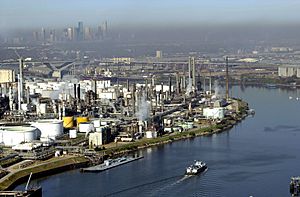
Texas has about 1,150 seaports along its coast. These ports employ nearly a million people and handle huge amounts of cargo. The Port of Houston is the busiest port in the United States for foreign cargo. It is also one of the top ten busiest ports worldwide.
Railroads in Texas
Texas has led the nation in railroad miles since 1911. The first railroad in Texas opened in 1853. In the past, ranchers used railroads to ship cattle to markets.
Today, several public transit agencies provide train service in Texas cities. Dallas, Fort Worth, Austin, and Houston all have commuter or light rail lines.
Amtrak also provides passenger train service to Texas with three routes: the Texas Eagle, the Sunset Limited, and the Heartland Flyer. There are also plans for a high-speed rail line between Dallas and Houston.
Sports in Texas
While American football is very popular, Texans enjoy many different sports.
Texas has several professional sports teams:
- Two NFL teams: the Dallas Cowboys and the Houston Texans.
- Two Major League Baseball teams: the Houston Astros and the Texas Rangers.
- Three NBA teams: the San Antonio Spurs, the Houston Rockets, and the Dallas Mavericks.
- One NHL team: the Dallas Stars.
- One WNBA team: the Dallas Wings.
- Three Major League Soccer teams: Austin FC, Houston Dynamo, and FC Dallas.
College athletics are also very important in Texas culture, especially football. Texas has 12 Division I-FBS schools, which is the most in the nation. Many of these universities have strong rivalries, like the one between the University of Oklahoma and the University of Texas at Austin.
The University Interscholastic League (UIL) organizes sports and academic competitions for primary and secondary schools in Texas.
Texans also love the rodeo. The world's first rodeo was held in Pecos, Texas. The annual Houston Livestock Show and Rodeo is the largest rodeo in the world. The Southwestern Exposition and Livestock Show in Fort Worth is the oldest continuously running rodeo.
Texas Motor Speedway hosts annual NASCAR and IndyCar auto races. Austin's Circuit of the Americas hosts Formula 1 races and other major motorsports events.
Education in Texas
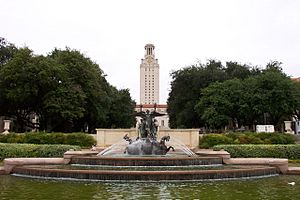
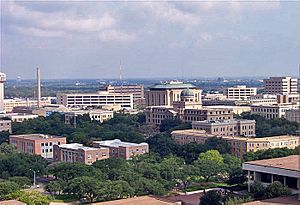
Mirabeau B. Lamar, the second president of the Republic of Texas, is known as the "Father of Texas Education." He set aside land to support public schools and universities, which helped create the state's public school system.
The Texas Education Agency (TEA) manages the state's public schools. Texas has over 1,000 school districts. These districts can collect taxes from residents to fund schools.
Students in Texas take the State of Texas Assessments of Academic Readiness (STAAR) tests. These tests check students' skills in reading, writing, math, science, and social studies.
Higher Education in Texas
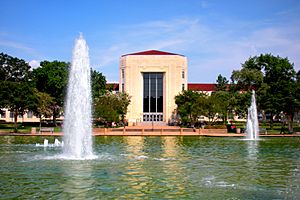
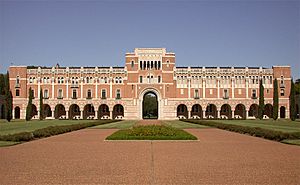
Texas has many great universities. The two most well-known public universities are The University of Texas at Austin and Texas A&M University. Other top public universities include the University of Houston and Texas Tech University.
Texas has 36 public universities, and most belong to one of six state university systems. The discovery of oil on university lands helped fund the growth of the two largest systems: the University of Texas System and the Texas A&M University System.
There are also many private universities in Texas. Rice University in Houston is a top-ranked research university. Trinity University in San Antonio is a highly-rated liberal arts college. Other private universities include Baylor University and Southwestern University.
Texas is home to three presidential libraries:
- The George Bush Presidential Library at Texas A&M University.
- The Lyndon Baines Johnson Library and Museum at The University of Texas at Austin.
- The George W. Bush Presidential Center at Southern Methodist University.
Texas Culture
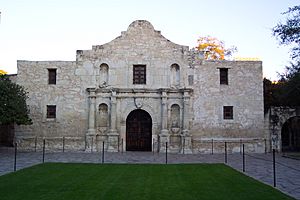
Texas culture is a mix of Southern, Western, and Southwestern influences. For example, the breakfast burrito, a popular food, combines elements from all three cultures. Over time, immigration has made Texas a diverse "melting pot" of cultures from all over the world. Areas near the Louisiana border even have a Cajun/Creole influence.
Texas has had a big impact on pop culture. The state is strongly linked to the image of the cowboy and country western music. The state's oil tycoons have also been popular in TV shows, like the hit series Dallas.
Images for kids
-
Captain Charles A. May's squadron of the 2nd Dragoons slashes through the Mexican Army lines. Resaca de la Palma, Texas, May 1846
-
Colonia in the Rio Grande Valley near the Mexico–United States border
-
Big Tex presided over every Texas State Fair since 1952 until it was destroyed by a fire in 2012. Since then a new Big Tex was created.
See also
 In Spanish: Texas para niños
In Spanish: Texas para niños



